Choquequirao – amazing ruins of Incas situated in the region of Cusco, Peru. It is a great alternative in relation to the famous Machu Picchu, because is not so crowded and for some even more spectacular. More about general information about this unique place in my article “Choquequirao ruins as a beautiful place to visit in Peru“. Here I would like to describe some of experiences during my trek to Choquequirao, which I did on November.
My 3-day Choquequirao trekking in Cusco
My expedition to this famous Inca ruins was quite hard but definitely worth the effort. Our team counted 4 people. At the beginning, we expected to overcome the route in 4 days, which is more or less standard. The idea was to rent a donkey and its owner (arriero), but we set also the possibility that we may fail this plan and you will have to carry everything yourself. Because of that, everyone took minimum number of things and our adventure started.
As a rule, Choquequirao trek in Cusco begins in the town of Cachora. So first you have to get to this town. Defeating the route Cusco – Cachora (including change in Curahuasi, because there is no direct connection) takes about 4 hours.
To bypass compulsory stops on the route due to road works, we decided to go from Cusco to Curahuasi at 4:00 am. Price per person in a tight bus – 15 soles. After 3 hours we reached this town. Here a quick breakfast – quinua with a sandwich with cheese (delicious) and bargaining with the taxi driver about the price for the drive to the village of Cachora.
After negotiating quite favorable prices, we started our next part of the trip. After less than an hour we were almost in Cachora. Almost, because as it turned out, a few kilometers away from the town road is impassable. There are currently renovations on this road, and seeing the pace of work, the road probably will be impossible to pass for the next few months. So if you are planning the trip to Choquequirao, be prepared for extra surprises on the way.
Therefore the last 2 maybe 3 km- shortcuts, we had to overcome on foot. On the beginning the rain greeted us, but we were not surprised, because the rainy season began on good. To the town of Cachora we arrived at about 9:00 am. In the first place we went for a meal. Part of the team tasted caldo de gallina and due to the fact that this soup is not my favourite, I went in search of other goodies. I found quinua which completely satisfied me.
After the meal we began to search for transport of our equipment that is arriero and a donkey. The case proved more difficult than we could predict. Practically the rainy season, already after season, and here all arriero hired. It was only after about an hour of searching we were able to get one, but with a more favorable price for us there was no question. Our arriero presented the conditions: we have to pay for four days, even as the route we will do in three days, and of not less than 35 soles per donkey and 30 soles per arriero. Total 65 soles per day that is 260 soles for 4 days. Due to the fact that was the only arriero who we were able to find, well, and due to the fact that no one wanted to carry on the back 4-days equipment, we do not even thought about any haggling. Quickly we accept the conditions and we could finally, about 11am, hit the road.
If somebody would like to organize the trek on your own with the donkey and arriero in the high season – good luck. It can be impossible. Even on November, so after a season, we had a problem to find free arriero, so I can only imagine how it looks like during the months May-September. All companies have kind of agreements with arrieros, what is normal of course, and they book donkeys and arrieros for the season.
Important information!
Everyone, or almost everyone starts trekking in Cachora, where for at least 3 hours are wandering through the usual road, available for cars, to the place called Capuliyoc (before that point there is a house).
Actually, walking trail (not available for cars) begins not in Cachora but near the Capuliyoc pass. Due to the fact that the first part Cachora – Capuliyoc can be done by car, we decided to skip this part and we took a taxi.
Personally I do not see the point to make this part of the trip on foot. As if it was not these are the 3 hours the first day, and then another 3 hours on the last day (because it returns along the same path). It is easy part to overcome, because it is flat, but it’s still a lot of km. That is why it is worth to bypass this part with the car due to other much more demanding sections. Our team from the very beginning had such a plan. So in Cachora we rented taxi, which for 40 soles took us to Capuliyoc. The trip lasted less than half an hour. Thanks to that we saved at least 2.5 hours, all the energy and all the forces.
Important note!
If you intend to organize trekking to Choquequirao on your own, skip the route Cachora – Capuliyoc and take a taxi! For quite small amount of money you will save a lot of time, effort and energy. It will also make it easier to complete the trip in 3 days. If you will do the trek in 3 days, you will gain one extra day, which you can utilize for exploring other places whether in the region of Cusco, or in other parts of Peru. But in the same time I note that overcoming the route in 3 days, requires really significant effort, so this option is rather only for these of you who love to walk a lot of hours, are in very good physical condition and are not afraid of the pain that might appear during the expedition – here mainly knee pain, which for sure will appear.
Important note!
If you decide to to Choquequirao trekking with the company, ask first if they start the trekking from Cachora or from the house near Capuliyoc! If they start in Cachora chose another company. Actually there is not to many of them who skip that first part. For sure Inka Jungle Tour do it, so you can check their offer.
How to plan Choquequirao trek in 3 days – day by day
Day I
On the first day we did the part from Capuliyoc to Santa Rosa. If you are not going to cook by yourself, try to hike a little higher, more or less 40 minutes longer, where lives one family and where is another camping place.
During that day first, we descended down to the valley – to the river. This place is called Playa Rosalina (here we crossed the bridge).
Till that place it was downhill all the time. But there is nothing to be happy, because as it descends down a few hours, you will feel the knee, what is the worst part of this trekking.
I did not have to big problems but my friends who are not hiking too often, they had some problems with this part.
After crossing the river, for a change, you will have a steep part to overcome.
All the time up, up and up – in total around 5,5 – 6 hours. The first day we did 2 hours of this part, to a place called Santa Rosa. Total time of trekking with breaks: from 11:45 to 17:00.
In Santa Rosa there is a camping with a shower and toilet. There is also a shop where you can buy drinks, snacks and sweets. For example, the water of 0.65 liters costs 4 soles, the bottle of water 2.5 liter costs 12 soles. In this place lives one family which prepares meals for tourists. Due to our laziness and a desire to support locals we decided to order dinner. Price for spaghetti, very large portions and delicious, was only 9 soles. Overall, there are some different dishes in the offer, and the price ranges from 6 to 10 soles.
For camping in Santa Rosa we paid 5 soles from the tent. In the price was included a shower. That the shower provided only cold water, but it was the best shower I’ve ever had. The water was not icy, and in view of the prevailing climate here, hot and very humid, it was perfect option.
Day II
To avoid the heat, which significantly impedes trekking and to complete the trip in three days, the second day we started quite early. We woke up at 4:30 in the morning, and we went in the way at 5:15 am. The first around 3 hours were quite hard – all the time up until the small village called Marampata. Extra effort compensated views.
We walked almost in the clouds, which changed the direction every minute, disclosing spectacular views. In the village Marampata we stopped for a short rest and breakfast.
In one of the shops we bought fruits and water and continued our journey. From the checkpoint, where the tourists have to pay entrance tickets to Choquequirao (37 soles) you can already see huge terraces built by the Incas. Due to the fact that this part of the route we defeated early in the morning, the clouds that stretched out over the entire complex of archaeological added to this place an extra dose of mystery. Something amazing. At the checkpoint, we found no one, so after the break for taking some photos, we continued the route. Ruins of Choquequirao appeared one hour later. In the middle of the road we came across a guard for whom we had to pay the 37 soles for entrance ticket.
We arrived to the ruins around 8:45 am. We had a few hours to explore this unique and beautiful place. We were a little tired but in the same time very happy. We had Choquequirao only for us. Amazing place, far away from everything. We felt like at the end of the world. The view from this place is wonderful. You can see some different valleys below and even snowy peaks around.
My favourite place was in the section of llamas. I loved that part. What’s a pity that only a small part of it is cleaned. The huge part of that section still is under the trees and other plants.
Around 12:30 pm we started to come back to Santa Rosa, where we arrived around 4 pm. After short break we continued the trek down to the river – Playa Rosalina. Here we decided to stay for a night. After taking cold, fresh shower we prepared delicious food and went to sleep. We were quite tired, because the last 4 hours of the route were hard, especially for our knees. All the time down, down.
Day III
The third day we started as early as the last two days. This time, we woke up at 4:00 am. Quick packing of our things, submission of tents and time to start trekking. Part of our team had a lot of problems after second day, especially muscles and knees made themselves felt. From Playa Rosalina we had uphill all the time, about 2 hours.
Then, there was some parts flat and finally ,the last part of the trip – uphill again. For me personally, this day was easy, but we all found that I am kind of exception and that in general for every one is quite hard.
The whole trek we ended around 11:00 am. I mean, at this time we were in a place called Curahuasi. Normally from this point, or rather from the house which is situated near this point, everyone wanders another 3 hours to the village of Cachora. But as I mentioned before, this part we overcame by car.
In Cachora we had to catch a taxi to Curahuasi, What was not so easy. We had to wait for the first opportunity around 40 minutes. The next 15 minutes it took us haggling with the taxi driver for a convenient price. Fortunately, the taxi driver relented, and took us to the main road where we could catch a next taxi to the village Curahuasi, from where there was a bus to Cusco.
We arrived to Curahuasi before 2 pm and luckly we catched the bus to Cusco for 15 soles. In Cusco we were before 6 pm. The first thing we did fter arriving to Cusco was a dinner, huge dinner and drinking a lot of chicha morada and lemonada.
That was a really great 3 days Choquequirao trek :-).





















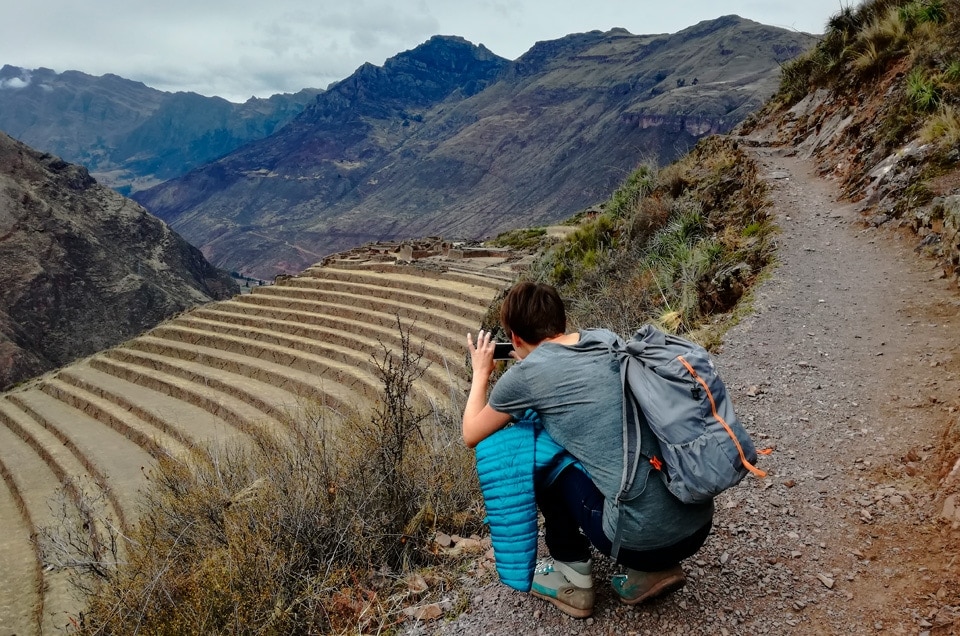
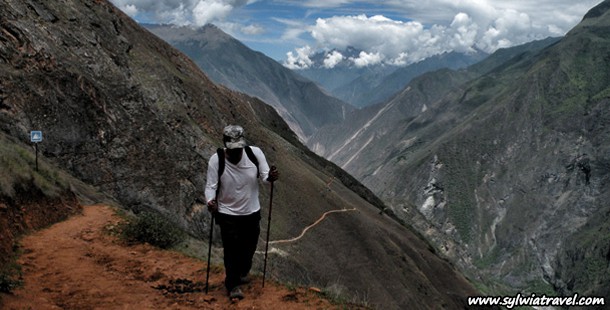
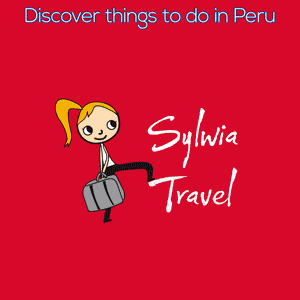
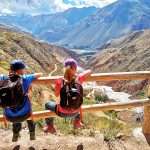

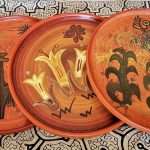
5 Comments
Hej Julia,
Zapomniałam jeszcze dodać, że w peru jest sporo miejsc, gdzie możesz wypożyczyć i namiot ikarimatę i śpiwór. Co do ich jakości, to bywa różnie, ale da się wyszukać dobry sprzęt, tyle że w cale nie będzie tak tanio. Bo wypożyczenie tych wszystkich rzeczy na kilka dni będzie kosztować raczej nie mniej niż 40 $ a może i sporo więcej.
Hej Julia,
Oj fajnie, że planujesz podróż do Peru :-). Mam nadzieję, że też Ci się ten kraj spodoba 🙂
Jeżeli chodzi o Choquequirao, to tu na penwo jest jedno miejsce, gdzie można zjeść ciepły posiłek. Dwa pozostałe czasem są, czasem nie, więc trudno przesądzić. Ten posiłek pewny jest w miejscu, do którego co do zasady wszyscy docierają drugiego dnia. My dotarliśmy pierwszego, bo po pierwsze bardzo szybko wędrowaliśmy, pomimo zmęczenia, a po drugie pierwszą część trasy, którą zazwyczaj każdy pokonuje pieszo, co w mojej ocenie jest bezsensowne, pokonaliśmy samochodem (zaoszczędziliśmy dzięki temu około 3 godzin wędrówki).
Co do noclegu, to zawsze musisz mieć cały sprzęt campingowy. Możesz obyć się bez kuchenki, ale nie jest fajnie spędzić 3 lub 4 dni w górach bez gorącej herbatki. Po drodze da się coś kupić, są przynajmniej dwa-trzy sklepiki, ale z bardzo podstawowymi rzeczami. Herbatę da się tam załatwi, tyle że nie wiadomo kiedy,w których momentach do nich dotrzesz. Wszystko zalezy jak zaplanujesz trasę, czy będziesz szła z plecakiem, czy wynajmiesz konika, który Cię w tym wyręczy, itp.
Jeżeli chodzi o Salkantay, to też w mojej ocenie trzeba mieć cały sprzęt. Tu dodatkowo zdecydowane cieplejszy śpiwór. Tu są po drodze miejsca gdzie da się przespać, ale bardzo często, szczególnie w szczycie sezonu są pozajmowane przez firmy, które organizują wyprawy. Da się obyć bez kuchenki, bo są punkty w których można coś kupić do zjedzenia. Ale musisz pamiętać, że te punkty są od siebie sporo oddalone, jak Ci się nie uda do nich w ciągu dnia dojść, to zostaniesz bez jedzenia. Wszystko zależy w jakie masz tempo, ile godzin dziennie chcesz wędrować. Ogólnie, jak chodzisz dość szybko, to nie powinnaś mieć problema.
Poza tym kolejna sprawa, jeżeli jesteś sama, to odradzam wyprawę samodzielnie. W przypadku Salkantay – jest bardzo wysoko, więc jak będziesz mieć problem z wysokością, to nie koniecznie będziesz mogła liczyć na pomoc. W ogóle w Peruwiańskich Andach najlepiej zawsze iść z kimś, szczególnie gdy wybierasz się w góry na kilka dni. Często zdarza się, że albo ludzie mają problemy z powodu wysokości, albo np. zwichną sobie kostkę, albo coś jeszcze. Niby nic strasznie groźnego, ale w takich przypadkach zawsze przydaje się pomoc innej osoby. Ja co najmniej kilkakrotnie byłam już świadkiem tego typu sytuacji, stąd też moja rada. Oczywiście może być tak, że się nic nie stanie i oby zawsze tak było, ale z uwagi na to moje doświadczenie, czuję się zobowiązana o tym wspomnieć :-).
Mam nadzieję, że te informacje w jakiś sposób Ci pomogą. Jeżeli masz inne pytania, daj znać.
Pozdrawiam Cię bardzo serdecznie!
Sylwia